Exhibition SONIC PATTERN is curated by Janis Jefferies, professor at Goldsmiths College of London University, Kaunas Biennial expert and partner since 2007, and Karen Gaskill who is also curating a SONIC PATTERN AND THE TEXTILITY OF CODE seminar at Kaunas Biennial programme. Artists who exhibit also participate at seminar talks, workshops and performances. This way both programme’ parts, presented by Crafts Council (the exhibition and the seminar) generate a very dynamic and high quality result.
INFORMATION ABOUT ARTISTS AND ARTWORKS, pesented at exhibition (prepared by Karen Gaskill)
James Bulley TACTUS

James Bulley. TACTUS. Score Study II, London Printworks Trust, Brixton, London (9 — 15 February 2012)
Photograph: Nick Street
The Tactus series is an investigation into direct communicative artworks for the blind and visually impaired. The textile-based scores are haptic sound generating surfaces that celebrate the braille music notation system of Louis Braille and the graphic scores of Cornelius Cardew. Tactus explores the interweaving of the auditory and tactile, and offers a questioning of the nature of art objects and their presentation in galleries and museums.
The wealth of existing artistry and research that actively seeks inclusion for the blind in public art is notable, but amongst this breadth of material it is apparent that there is need for an accessible and intuitive artistic language that can allow a fully inclusive and unique experience of art for the blind. Whilst the common translation of publicly exhibited artistic relics into tactile diagrams and braille-based explanations is vital, it can prove problematic. Relics, most often from the field of visual arts, are translated from primarily optical to primarily tactile objects, causing a marked distance between the tactile representation and the pre-existing visual concept. These translations cannot be the original artwork; they are, at best, inspiring representations.
In galleries and museums where events are held that encourage interaction through touch, it is rare indeed to encounter an object that has not been conceived with the visual aspect as primary. Sound-based art works offer a noteworthy and welcome exception to this standard. In the creation of a haptic-based non-visual language, a sighted artist is hindered from the outset. Haptic and auditory sensations are blurred by existing visual perceptions. Just as a visual artwork can summon haptic perception at distance through sight, a haptic piece can summon the visual. As a result, the tactile development of the scores has been made possible through the patience and advice of a number of different blind and visually impaired audiences, alongside consultation with various researchers and organisations, who have freely lent their time and experience.
The tactile score on display within this exhibition is composed of numerous ‘cells’ of braille and graphic notations that form an overall sound composition. These ‘cells’ can be explored by touch, with the tactile and textural patterns varying based upon the sound material they represent. The sound score does not operate under any particular time signature or fixed global linear arrangement. This allows for a dynamic recombination of rhythmic and harmonic score material and a flexibility in exploration by the audience. The sound material heard from the work is drawn from a large archive of sound material recorded specifically for the piece in the months leading up to the installation. When a certain patterning of the tactile score is touched, related sound patterns are triggered from the sound archive and heard back instantly across a spatial array of speakers invisibly embedded behind the wall-mounted score.
With thanks to the Leverhulme Trust, Arron Smith (Artists & Engineers), Faye McNulty, Keir Vine, Daniel Jones and Havva Basto.
Documentation Portfolio: Printworks Trust, London (February 10-12, 2011)
Video: Intel Vice Creators Project interview for Score Study II
info@jamesjbulley.com | www.jamesbulley.com
Myrto Karanika, Jeremy Keenan PEACOCK, 2015
Medium: felt, spacer fabric, stainless steel knitted-mesh band, embroidery thread, custom circuitry, microcontroller, custom software
The rug as an artefact is so deeply grounded in our quotidian experience of the domestic interior and of ‘home’ that its presence invariably connotes a place of familiarity and comfortable care that invites tactile contact and encourages bodily engagement. One may slow down to walk on it and experience the sinking feeling underfoot, or they may choose to sit, or stretch out and rest flat on it to enjoy the comfort of its softness and warmth. Its haptic richness and proximity to the floor triggers sensory experiences that are embodied, or ‘grounded’, akin to lying down.
A collaboration between textile artist Myrto Karanika and sound artist Jeremy Keenan, Peacock explores relations between space and bodily expression through the novel use of technology and traditional art practices such as printmaking, stitching and embroidery. The work creates a sense of continuity that joins ongoing developments in the field of interactive artistic production with the long history of rug making.
Reflecting the textile references Myrto grew up with, Peacock’s pattern is a contemporary take on motifs one frequently comes across in traditional post-Byzantine textile craft. Hellenic culture has been inextricably interlaced with that of the Islamic world for centuries. The influence of the Middle East, particularly Asia Minor, is very evident in the themes and spiritual values underpinning Greek folk art as expressed through the use of bright, bold colours and the depiction of floral and faunal elements that bear a symbolic significance.
The visual impact of the rug’s patterns and colours, interwoven with the tactility and warmth of its materials, invites us to open up our sensory channels and to immerse ourselves in space through all of our senses. The work’s highly multisensory nature asks to be explored through the eyes, the hands, the limbs and the whole of the body; the rug has a transitional quality that creates space within space and signifies a plateau for different types of engagement and qualitative attention.
As different relations between people’s activities form and dissolve over time, they are sonically communicated through an evolving soundscape, the composition of which relies on the technology underlying the tactile sensitivity of the rug. A grid of conductive ‘nerves’ running through the deep tissue of the rug captures any touch or movement along its surface and transforms it into a smooth, open-ended, non-predetermined soundscape. The flow of data generated by people’s physical interaction with Peacock is passed to custom sound software created by Jeremy. The software uses the stream of generated data to compose an evolving, ambient soundscape in response to various performed activities. As the rug is being walked on, touched, stroked, and pressed, the sound software encodes these gestures on different spatial and temporal scales, continuously generating sonic output that ranges from short, staccato bursts to expansive, harmonic sound fields.
www.jeremykeenan.info / www.callandresponse.org.uk
Scanner, Ismini Samanidou WEAVE WAVES
Weave Waves was commissioned for the Crafts Council’s touring exhibition ‘Sound Matters: Exploring sound through forms’, which launched in May 2013, and explores how and where the worlds of sound and craft collide.
Weave Waves explores sound, geography and mapping, how this data relates to both textile weave structures and musical scores.
Scanner and Samanidou have been inspired by the visual and technical similarities between the digital software they both use, the physicality of code and how this, in turn, relates to mechanisms for mapping cities and recording the sounds of a city. Samanidou recognises code as tactile and visible and Scanner sees code as hidden and veiled beneath the surface, but they both use a shared language of zeros and ones – of binary code.
The work exists in multiple stages, with the video revealing the approach to working together, sharing contexts, and considering the commonalities across practices. The duo then developed a series of small woven pieces and a sound work, which are currently still touring as part of ‘Sound Matters’.
http://scannerdot.com
http://www.isminisamanidou.com/
Fabio Lattanzi Antinori DATAFLAGS
Dataflags deals with the notion of failure and bankruptcy in the corporate world; it focuses in particular on the rise and fall of Lehman Brothers, the financial institution that was thought to be too big to fail and which instead filed for bankruptcy on the 15th of September 2008.
Much inspired by corporate flags, which serve the purpose of glorifying the identity of companies worldwide, Dataflags is a screenprinted large sheet of paper, printed black on the front and gold on the back, to allude to the old standards (gold and oil), which served as reference to the financial market, up until the Bretton Woods system was abolished.
It is a flag, but one of failure and bankruptcy.
The artwork depicts a different insignia, one that might reveal the innate fragility of trust in a system that is entirely based on faith and common agreement, as after all the whole idea of money and credit, as novelist John Lanchester described it, is “a collective act of the imagination”.
Dataflags uses a database of the historical share price data from Lehman Brothers, in order to narrate, through the voice of a soprano singer, the ups and downs of the company; in so doing, Dataflags questions the authority played by data in decision making scenarios, with a particular relation to the unpredictable financial system, by highlighting the risk of seeing data as the oracle of absolute truth and data analysts as the new prophets.
The paper, which was screenprinted by hand by carefully layering Bare Conductive Electric Paint and non-conductive ink on a sheet of Somerset paper, contains conductive areas, which act as sensors and actuate the interaction; when the audience touches the surface of the flag along any of the large sensors and on either of the two sides (front or back), this in return tells the story of Lehman Brothers, by singing the share price of the company at a specific moment in time, starting from 15th of September 1998.
Every time it is touched one set of data is sung; every five times it is touched, a day of trade is being narrated. The archive of data created for the artwork allows for it to sing until 15th September 2008; the pre-recorded voice of the singer is being assembled in real-time, through a custom code written in MaxMSP, which gives the impression that a singer is singing each one of the thousand data entries, each time the surface of the work is touched.
By using a language that is known only to a few experts in the field of finance, but which strongly influences and shapes our everyday life, Dataflags uses the presence of a soprano voice to transform this story into a contemporary take on a tragedy of our times.
Dataflags was realised for the Victoria and Albert Museum, London, as part of the Digital Weekend; it was exhibited at the Guest Projects (Shonibare Studio), London, as part of the Executive Chair residency program and at the Museum of Contemporary Cuts, as part of the Executed show.
Knyttan & Common Works RECOUNTED AN ORAL SAMPLER
Recounted is an exploration in creating a collaborative artwork using Knyttan’s groundbreaking knitting technology. As part of the Digital Weekend (2021 September 2014) at the Victoria and Albert Museum, London, visitors were invited to record themselves speaking, singing or chanting. This audio information was then automatically converted into traditional Scottish inspired knitting patterns, which were then knitted out at regular intervals throughout the weekend, before being delivered to the V&A and added to the artwork. Before the Industrial Revolution, most knitwear was produced by small groups of women who – as they knitted – sang songs together to keep count of the number of stitches. We wanted to recapture this folk heritage of knitting in a contemporary way, drawing inspiration from the communal approach to production and the songs those communities sang. Playing off the idea of samplers in both music and textiles, these audio snippets create the patterns that are knitted. Each line of Fair Isle equates to a visual communication of the pitch and volume of each individual recording. The patterns and knit techniques chosen to express this are all taken from traditional British hand knitted garments and samples found deep in the Victoria and Albert Museum archive.
Exhibition information:
Exhibition venue: M. Žilinskas Art Gallery
Address: Nepriklausomybės sq. 12, Kaunas
Working hours: Mon-Sun 11am-5pm
The exhibition lasts until 31 Dec, 2015



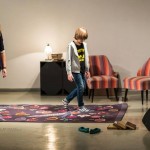


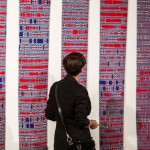

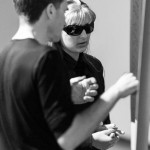

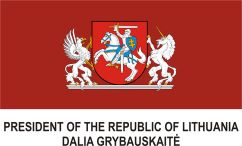

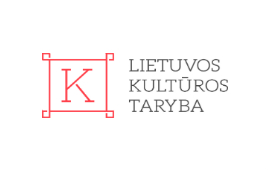
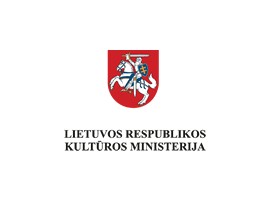
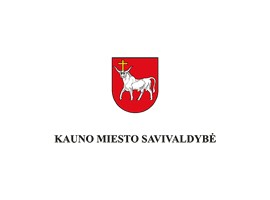










Leave a Reply